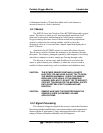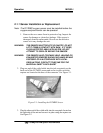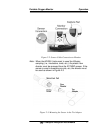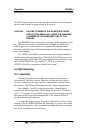
Portable Oxygen Monitor Operation
Teledyne Analytical Instruments 21
made to the settings. If the batteries have just been installed
the LCD will flash 00.0
4. As with most oxygen analyzer(s) the highest level of
accuracy is achieved when calibration is conducted using
100% oxygen. After installing the flow diverter as noted in
Section 2.1.1, insert the sensor into the plastic tee and
connect to a supply of pure dry oxygen flowing at 1-2 liters
per minute.
Note: An accessory calibration assembly (P/N C53790) is
available from Teledyne for use with the R17MED sensor
5. Wait about 20 seconds to insure the sample line is completely
purged with the calibration gas. Press the CAL key. The
LCD will count down from 9 to 0. During this time the
microprocessor is measuring the sensor output to determine
the gas concentration and selects the calibration range i.e.
100% or 20.9%. When the calibration is complete the LCD
will display the gas value. Press the LOCK/UNLOCK key to
save the calibration data.
Note: The MX300-I can only be calibrated using 100% oxygen or
room air 20.9%. Improper calibration or use of other gas
concentrations will activate the
√
SENSOR indicator. To
repeat the calibration press the LOCK/UNLOCK key and
press the CAL key.
6. Remove the sensor from the oxygen supply and confirm the
LCD reads less than 22% in room air. It is not necessary for
it to read exactly 20.9%.
7. It is important to perform the calibration carefully and
thoroughly, using calibration gases that are free from
contaminates. Wait for a stable reading before locking in
calibration point. The accuracy of the instrument is only as
good as the procedure used to calibrate it.
Note: A single point air calibration is not recommended unless
the sensor can be exposed to a known source of fresh
outdoor air. Hospital room air is often enriched with
excess oxygen, which will introduce errors into the
calibration. Air calibration should only be used for
monitoring oxygen levels between 21% and 40% and


















